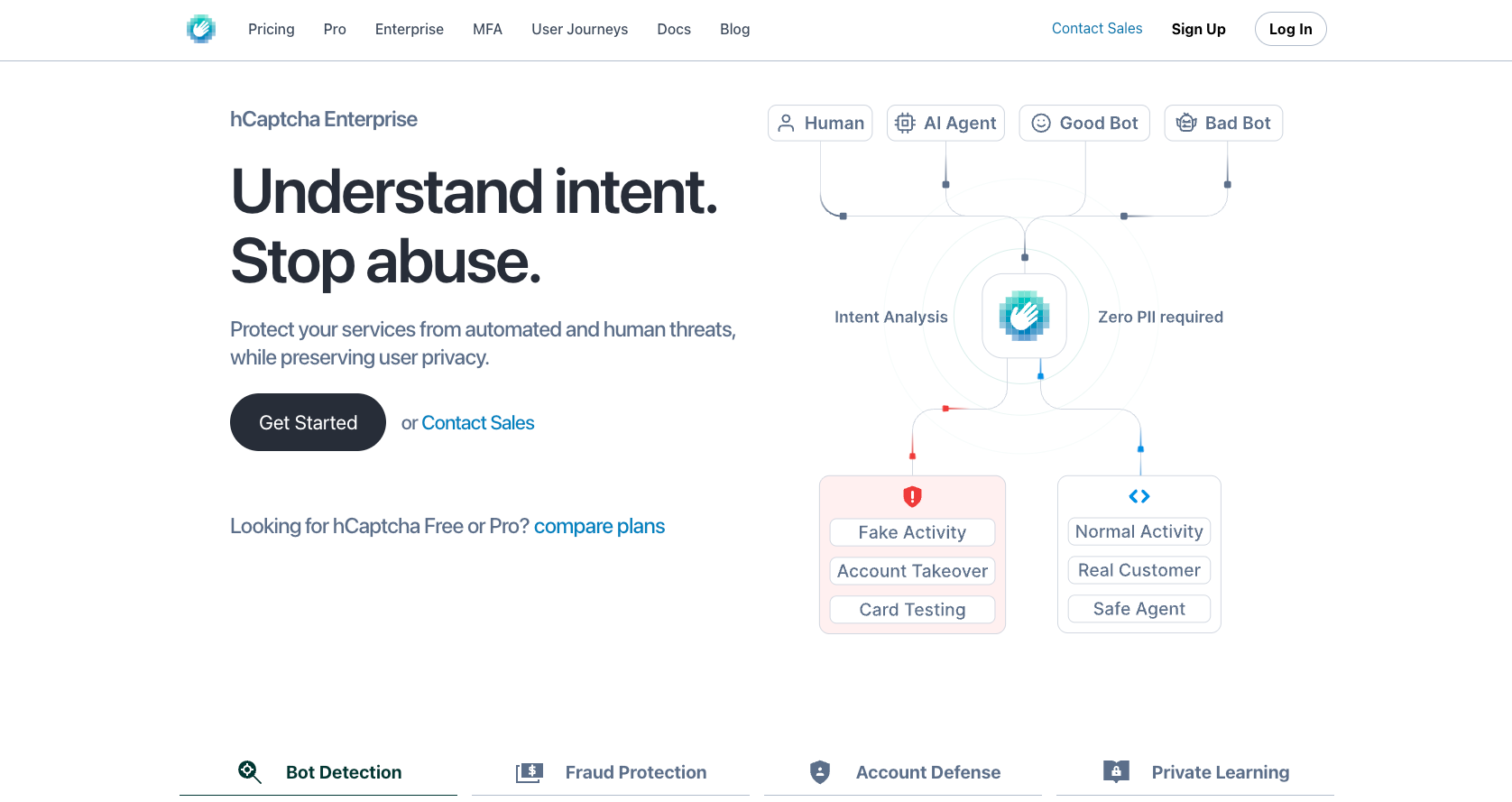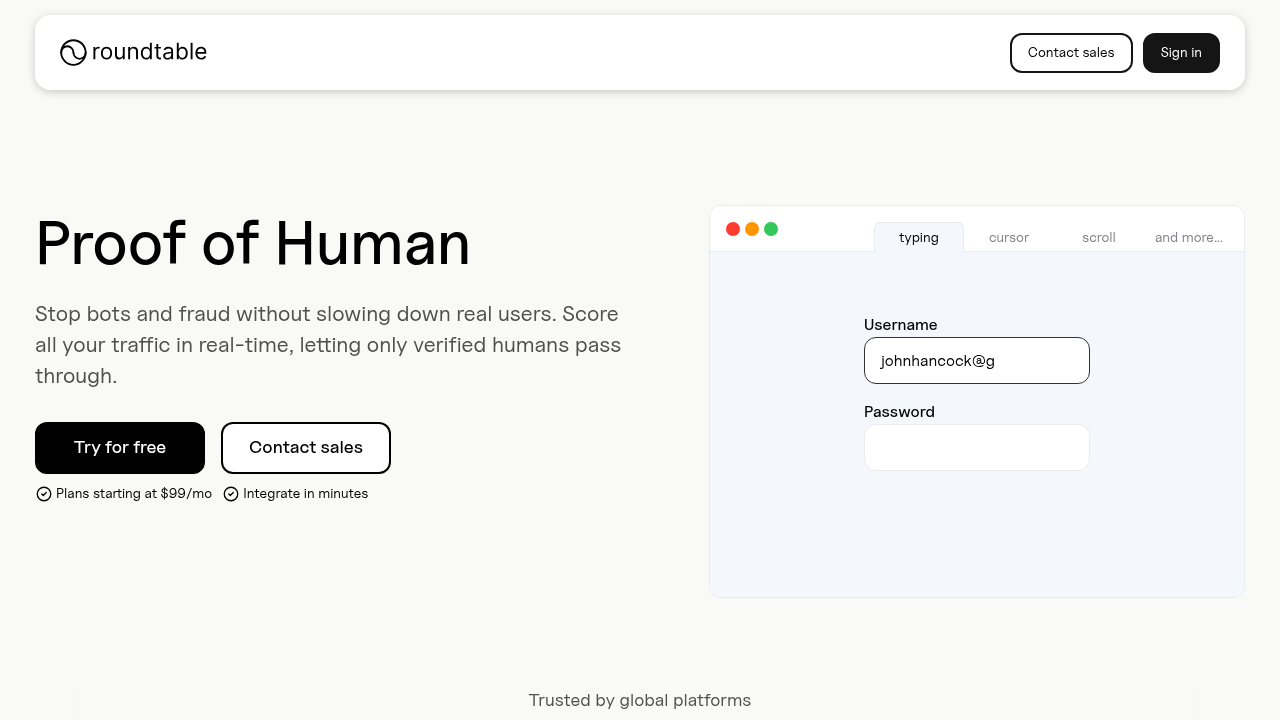11/11/2025. You need to block bots without annoying every legitimate visitor who lands on your site. That's where the CAPTCHA dilemma lives. If you're comparing
hCaptcha pricing and alternatives, you're probably looking for something that protects your forms without making users solve puzzles. Here's what hCaptcha offers, what it'll cost you, and whether there are better options for 2025.
TLDR:
- hCaptcha forces users to solve image puzzles that can require up to 10 attempts, reducing conversion rates.
- AI bots now solve 28-60% of traditional CAPTCHA challenges, making puzzle-based verification less effective.
- Roundtable detects bots invisibly using behavioral biometrics with 87% accuracy and zero user friction.
- Alternatives like reCAPTCHA and Cloudflare Turnstile still interrupt workflows when suspicious activity appears.
- Roundtable achieves invisible bot detection through behavioral analysis while maintaining GDPR compliance.
What is hCaptcha and How Does it Work?
hCaptcha is a CAPTCHA service that asks users to solve image recognition puzzles to prove they're human. You've probably done one yourself: click all the images with traffic lights, bicycles, or buses. Humans can identify objects in pictures, while bots struggle with these visual tasks.
The service runs on machine learning models trained to distinguish between human behavior and automated scripts. When you land on a protected page, hCaptcha analyzes your interaction patterns and decides whether to show you a challenge. If the system suspects bot activity, you'll need to solve one or more image puzzles before proceeding.
hCaptcha offers different challenge types and difficulty levels depending on how much risk a site wants to mitigate. Organizations can customize the experience to balance security with user friction. The service works across login pages, registration forms, checkout flows, and anywhere else that spam or automated abuse is a concern.
The user base spans e-commerce sites, fintech companies, gaming studios, government agencies, and privacy-focused services. One reason hCaptcha gained traction is its
privacy compliance and rapid deployment. hCaptcha positions itself as a privacy-first option that doesn't sell user data or track individuals across the web.
hCaptcha Features
hCaptcha features can be looked at across three key categories:
- Core verification features
- Infrastructure and enterprise options
- Plans and integrations
Core Verification Features
hCaptcha uses image-based challenges where users identify objects like traffic lights, bicycles, or buses in a grid of pictures. A machine learning engine analyzes interaction patterns to assess threat levels and determine when challenges appear.
Organizations can configure challenge difficulty and frequency based on risk tolerance. Lower-risk scenarios support passive mode where most users pass without seeing a puzzle. Higher security settings trigger more frequent or complex challenges.
Infrastructure and Enterprise Options
hCaptcha operates across over 250 global locations, processing verification requests close to each user while keeping data ephemeral. Zero PII modes avoid collecting personal information during verification.
Enterprise customers access Private Learning that trains detection models on specific traffic patterns, custom challenge creation with proprietary images or questions, and dedicated support with SLAs.
Plans and Integrations
hCaptcha offers three tiers:
- Free for basic CAPTCHA functionality
- Pro with enhanced features and analytics, and
- Enterprise with custom threat models.
All three tiers provide analytics dashboards which track verification attempts, success rates, and threat patterns. In addition, the service integrates with frameworks including Angular and WordPress for straightforward deployment.
hCaptcha Key Limitations and Gaps
While hCaptcha is a well-known and well-regarded security tool, it does have some limitations and key gaps including:
- User friction and conversion impact
- Accessibility barriers
- Technical integration
- GDPR compliance uncertainty
User Friction and Conversion Impact
Image recognition puzzles require users to complete multiple verification attempts. You'll see visitors clicking tiles with traffic lights or buses, sometimes facing up to 10 attempts before successful verification. This trial-and-error process creates friction that reduces conversion rates. Tile selection accuracy compounds the problem. Users can't determine whether partial objects count, like a small sliver of a traffic light in a tile's corner, leading to failed attempts from people genuinely trying to complete verification.
Accessibility Barriers
hCaptcha provides accommodation features for users with disabilities, but these workarounds still require extra steps. Invisible verification methods that need no user interaction provide better universal access than solutions asking certain users to take additional actions.
Technical Integration Problems
Content Security Policy directive violations can block hCaptcha scripts from loading, breaking forms with no visible CAPTCHA. Users click verification fields that load indefinitely or never appear, leaving visitors unable to proceed.
GDPR Compliance Uncertainty
hCaptcha participates in the
EU-US Data Privacy Framework, but data protection experts question whether US-based services fully satisfy GDPR requirements. European legal consensus suggests processing EU user data through American providers carries compliance risk for organizations in regulated markets.
Best hCaptcha Alternatives in November 2025
Roundtable solves the core problem with hCaptcha: our invisible behavioral biometrics approach analyzes typing patterns, mouse movements, and interaction timing in the background. Legitimate users never see a challenge or puzzle while sophisticated bots get blocked in real-time. No more stoplights, no more bicycles, no more puzzles.
The difference shows up in both user experience and detection accuracy. Roundtable's behavioral analysis combined with device intelligence achieves 87% detection accuracy, outperforming CAPTCHA-based systems. Our privacy-first design collects no personal identifiable information while maintaining full GDPR and CCPA compliance.
Comparing Top Alternatives
| Alternative |
Approach |
User Friction |
Best For |
| Roundtable |
Behavioral biometrics + device signals |
Zero (invisible) |
Organizations prioritizing both security and user experience |
| Google reCAPTCHA |
Risk analysis + occasional challenges |
Low to medium |
Google ecosystem users |
| Cloudflare Turnstile |
Browser verification |
Low |
Sites already using Cloudflare |
| Friendly Captcha |
Cryptographic puzzles |
Low |
Privacy-focused European sites |
| DataDome |
Bot management suite |
Low |
Enterprise e-commerce |
| Arkose Labs |
Interactive challenges |
Medium to high |
Gaming and high-risk environments |
Google reCAPTCHA remains the most widely deployed CAPTCHA service, using Google's massive data advantage for risk scoring. The system shows fewer challenges to users it considers low-risk, though it still interrupts workflows when suspicious activity appears. reCAPTCHA's
extensive integrations make deployment straightforward for most tech stacks.
Cloudflare Turnstile performs browser environment checks that happen invisibly for most users. The service integrates tightly with Cloudflare's CDN and security stack, making it a natural choice for sites already routing traffic through their network.
Friendly Captcha takes a privacy-centric approach by running cryptographic puzzles in the user's browser without sending data to external servers. This GDPR-compliant design appeals to European organizations concerned about data transfers, though the client-side processing can slow down older devices.
DataDome and Arkose Labs target enterprise customers with bot management suites that analyze device fingerprints, network patterns, and user behavior to build risk profiles, though they typically come at higher price points than basic CAPTCHA services.
FAQ
How does hCaptcha's image verification affect conversion rates?
Image recognition puzzles require users to complete multiple verification attempts, sometimes up to 10 tries before success. This friction directly reduces conversion rates as visitors abandon forms instead of repeatedly clicking tiles to identify traffic lights or buses.
What's the main difference between CAPTCHA-based and behavioral detection approaches?
CAPTCHA-based tools like hCaptcha interrupt users with puzzles to verify they're human, while behavioral detection analyzes typing patterns, mouse movements, and interaction timing invisibly in the background.
Behavioral approaches eliminate user friction while achieving higher detection accuracy (87% vs. 69% for traditional CAPTCHAs).
When should I consider switching from hCaptcha to an alternative?
If you're seeing conversion drops from verification friction, facing GDPR compliance concerns with US-based data processing, or dealing with accessibility complaints from users who struggle with image puzzles, it's time to look at invisible verification alternatives.
Can hCaptcha challenges be solved by AI bots?
Yes, advanced AI models can now solve
28-60% of traditional CAPTCHA challenges, making image-based verification increasingly ineffective against sophisticated bot attacks while still frustrating legitimate users.
How long does it take to integrate an invisible bot detection solution?
Most invisible detection solutions integrate in days, not weeks, typically requiring just a single line of JavaScript code and backend API configuration to start analyzing user behavior without showing any challenges to visitors.
Final thoughts on moving past image-based verification
When you compare
hCaptcha pricing against invisible alternatives, factor in the conversion loss from failed puzzle attempts. Every extra click costs you real users who give up and leave. Behavioral verification runs silently in the background and catches bots without asking anyone to identify traffic lights. When the security is invisible, you protect your site and your businesses while respecting your visitors.

